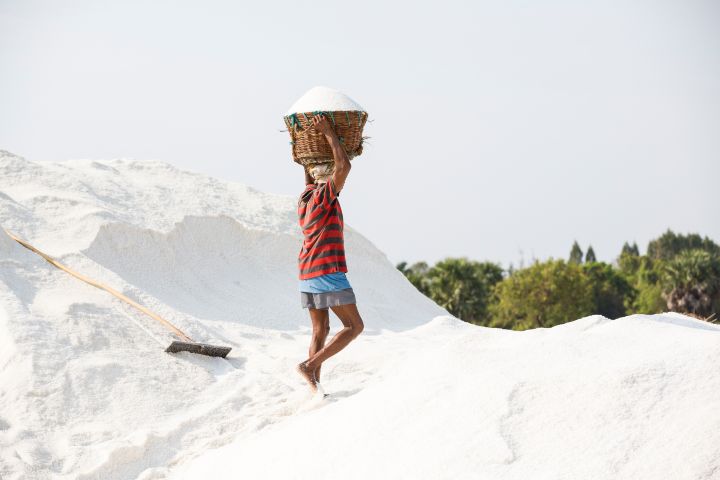India is one of the top salt producing nations, contributing a significant share of global salt production. The annual salt production in India is 307 lakh tonnes, making it the third-largest producer after China and the USA.
The Journey of India from a nation that imported salt to meet its domestic needs to becoming a major salt-producing nation is quite inspiring.
Let’s explore the overview of the salt industry in India and the factors that have contributed to the nation’s success.

Sources of Salt Production in India
India’s produces salt from four sources, which include
- Sea Brine
- Lake Brine
- Sub soil Brine
- Rock Salt
Seawater is an abundant source of salt. Its production is highly influenced by weather and soil conditions. Gujarat is India’s major contributor of marine salt, accounting 87.4% of the total output, followed by Tamilnadu (4.7%).
Whereas other coastal states like Andhra Pradesh, Orissa, Maharastra, and West Bengal contribute a fraction of India’s overall salt production.
When it comes to inland salt production, Rajasthan takes the centre spot. It produces salt by lake brine and sub-soil brine methods, contributing 6.7% of the share.
A fraction of the overall salt production in India also occurs via rock salt deposits mined in Himachal Pradesh.
Major Salt Producing States in India
In India, salt production is concentrated in specific regions within each state, serving as key industry centres and major export hubs. Below are details of the major salt-producing areas state wise.
Gujarat
Gujarat is a key player, featuring prominent locations like Jamnagar, Mithapur, and Bhavnagar. These areas are essential for producing marine salt, contributing significantly to domestic and international markets.
Tamil Nadu
Tamil Nadu’s major salt production centres include Tuticorin, Vedaranyam, and Covelong, contributing significantly to the state’s overall salt industry.
Andhra Pradesh
Having the second longest coastal line state next to Gujarat, AP contributes only a fraction of the nation’s salt production, around 2%.
Some key salt production areas in Andhra Pradesh are Chinnaganjam, Iskapalli, Krishnapatnam, Kakinada, and Naupada.
Orissa
Numerous small to medium-scale salt manufacturers are present along the Ganjam, Puri, and Balasore coastal districts contributing to Orissa state salt production. The average salt production capacity of the state ranges from 30,000 to 40,000 metric tonnes.
Maharastra
Most of the state’s salt production comes from small salt pans that rely mostly on traditional methods.
The sub-urban localities of Mumbai, Bhandup, and Bhayander have 40 salt pans spread across 5,300 acres. The state also has 4,000 acres of salt pans in the Konkan coastal town of Palghar and Vasai
West Bengal
Bengal has historically been a key trading hub for salt merchants during the Mughal and British eras. The state currently sources salt from various small salt pans in Contai, Bhandup, Bhayandar, and Palghar districts.
Rajasthan
Rajasthan contributes 8% to India’s overall salt production. It primarily sources salt from Sambhar Lake and regions such as Nawa, Rajas, Kuchhaman, Sujangarh, and Phalodi.
Himachal Pradesh
India’s only state producing rock salt is Himachal Pradesh, primarily extracted from two mines in the Mandi district, Gumma and Drang.
According to the National Mineral Inventory (NMI), the total estimated reserves of rock salt as of 2020 stand at approximately 12.78 million tonnes.
Key Facts about the Salt Production in India
- When India attained independence in 1947, it just produced 1.9 million tonnes of salt and imported additional salt from the United Kingdom and Aden to meet domestic needs.
- Today, India is the third largest salt producer in the world, next to USA and China.
- In 2021, the salt industry in India produced an estimated 21 million metric tons of sea salt. During the same year, rock salt production in the country reached 320 metric tons, while all other types of salt contributed to a total output of 5.2 million metric tons.
- Three states predominantly drive the Indian salt industry: Gujarat leads with 87% of production, followed by Tamil Nadu at 4.7% and Rajasthan at 6.7%.
- As of 2022, the Indian salt industry employs an average of 77,086 labourers.
- The Indian Bureau of Mines estimates that the per-capita consumption of salt in the country is about 14 kg, including both edible and industrial salt.
- As of 2022, the annual demand for edible salt is 6.3 million tonnes, while industrial salt requirements stand at 11.8 million tonnes.
- 97.12% of salt production in India comes from the private sector. The public and joint sectors contribute 1.11%, and the remaining production is from cooperative sectors.
Import and Export Capacities of Indian Salt Industry
India’s salt export has evolved significantly since independence in 1947. Initially, the country depended on imports from the United Kingdom and Aden to satisfy its domestic salt requirements.
Post-independence, India’s salt industry underwent significant transformation, marked by advancements in production techniques, a stronger emphasis on quality, and the emergence of more private players.
India is currently one of the largest salt exporters, exporting approximately 91 lakh tons annually to various countries for industrial and domestic applications.
Key importing nations include Japan, Bangladesh, Qatar, Indonesia, Malaysia, the United Arab Emirates, and Vietnam.
The country’s diverse range of salt products, including sea salt, rock salt, and speciality salts, continue to attract global markets, making salt export an essential part of India’s growth economy.
Import of Rock Salt
While India is self-sufficient mainly in salt production and has a strong export capacity, it still imports rock salt from several countries, including the UAE, Iran, China, and Pakistan.
India has already initiated a large-scale mining project at rock salt mines in Mandi to overcome this, with an estimated production capacity of 50,000 MT annually.
Once fully operational, this will eliminate the need to import salt from other countries.
Role of the Indian Government in the Salt Industry
The Indian government has been instrumental in improving the salt industry through various initiatives designed to boost production capacity, enhance the quality of products, and support the labour force. Key measures taken by the government to shape the salt industry in India include…
- Salt is a central subject in the Indian Constitution, listed as item No. 58 in the Union List of the 7th Schedule.
- The Central Government oversees the entire Salt Industry in India. The Salt Commissioners Organization, part of the Ministry of Commerce & Industry, is in charge of this responsibility.
- India has been at the forefront of promoting the use of iodized salt for everyone to help eliminate iodine deficiency disorders. This effort is part of a program called the National Iodine Deficiency Disorders Control Program (NIDDCP)
- The Salt Commissioners Organization has established several labour welfare schemes to enhance salt labourers’ working and living conditions. One such scheme is Namak Mazdoor Awas Yojana – The scheme provides housing for salt workers
Challenges of the Indian Salt Industry
The Indian salt industry is facing several challenges hindering its growth and sustainability. Here are some major roadblocks affecting the growth of Indian salt industry
- fluctuating demand and price volatility, which is adversely impacting the livelihoods of salt farmers
- Increased number of unseasonal rains and cyclones affecting sea salt production
- majority of the salt pans across India still use the age old methods for salt production, which is indirectly affecting the production capabilities.
- Insufficient infrastructure and limited access to markets make it difficult for smaller producers to grow, ultimately affecting the overall economy of the sector.
Scope of Improvement
India’s salt industry is rapidly growing and has the potential to become a global leader in production. However, it must address challenges like infrastructure development and expanding market access for small to medium salt farms to achieve this. Additionally, creating more employment opportunities is essential.









